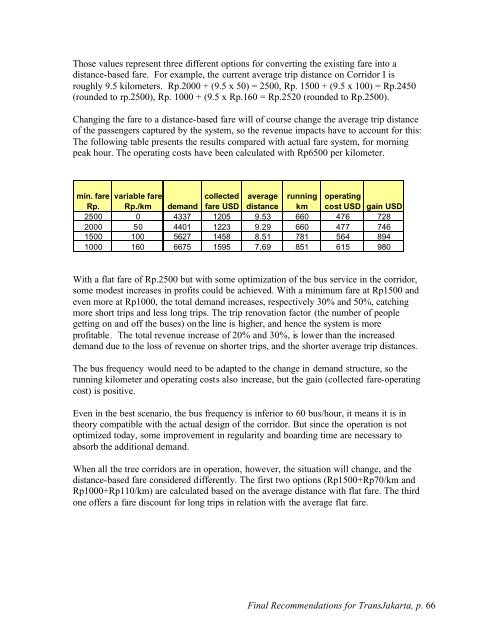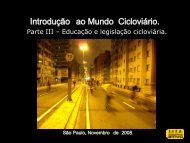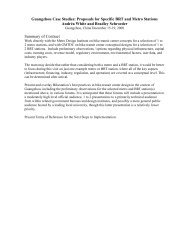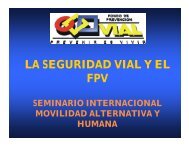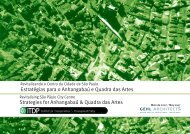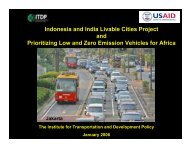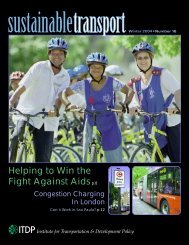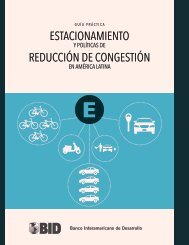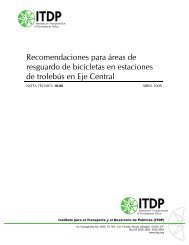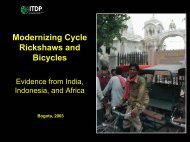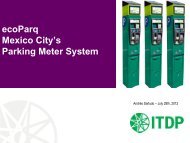Making TransJakarta a World Class BRT System - ITDP | Institute for ...
Making TransJakarta a World Class BRT System - ITDP | Institute for ...
Making TransJakarta a World Class BRT System - ITDP | Institute for ...
Create successful ePaper yourself
Turn your PDF publications into a flip-book with our unique Google optimized e-Paper software.
Those values represent three different options <strong>for</strong> converting the existing fare into a<br />
distance-based fare. For example, the current average trip distance on Corridor I is<br />
roughly 9.5 kilometers. Rp.2000 + (9.5 x 50) = 2500, Rp. 1500 + (9.5 x 100) = Rp.2450<br />
(rounded to rp.2500), Rp. 1000 + (9.5 x Rp.160 = Rp.2520 (rounded to Rp.2500).<br />
Changing the fare to a distance-based fare will of course change the average trip distance<br />
of the passengers captured by the system, so the revenue impacts have to account <strong>for</strong> this:<br />
The following table presents the results compared with actual fare system, <strong>for</strong> morning<br />
peak hour. The operating costs have been calculated with Rp6500 per kilometer.<br />
min. fare variable fare collected average running operating<br />
Rp. Rp./km demand fare USD distance km cost USD gain USD<br />
2500 0 4337 1205 9.53 660 476 728<br />
2000 50 4401 1223 9.29 660 477 746<br />
1500 100 5627 1458 8.51 781 564 894<br />
1000 160 6675 1595 7.69 851 615 980<br />
With a flat fare of Rp.2500 but with some optimization of the bus service in the corridor,<br />
some modest increases in profits could be achieved. With a minimum fare at Rp1500 and<br />
even more at Rp1000, the total demand increases, respectively 30% and 50%, catching<br />
more short trips and less long trips. The trip renovation factor (the number of people<br />
getting on and off the buses) on the line is higher, and hence the system is more<br />
profitable. The total revenue increase of 20% and 30%, is lower than the increased<br />
demand due to the loss of revenue on shorter trips, and the shorter average trip distances.<br />
The bus frequency would need to be adapted to the change in demand structure, so the<br />
running kilometer and operating costs also increase, but the gain (collected fare-operating<br />
cost) is positive.<br />
Even in the best scenario, the bus frequency is inferior to 60 bus/hour, it means it is in<br />
theory compatible with the actual design of the corridor. But since the operation is not<br />
optimized today, some improvement in regularity and boarding time are necessary to<br />
absorb the additional demand.<br />
When all the tree corridors are in operation, however, the situation will change, and the<br />
distance-based fare considered differently. The first two options (Rp1500+Rp70/km and<br />
Rp1000+Rp110/km) are calculated based on the average distance with flat fare. The third<br />
one offers a fare discount <strong>for</strong> long trips in relation with the average flat fare.<br />
Final Recommendations <strong>for</strong> <strong>TransJakarta</strong>, p. 66


